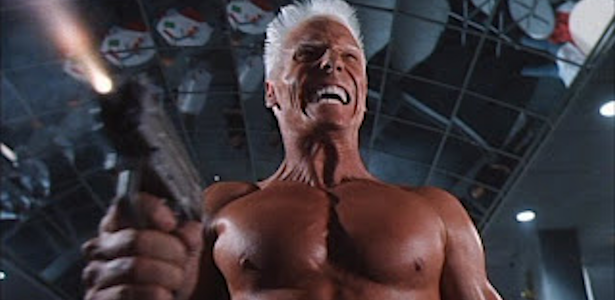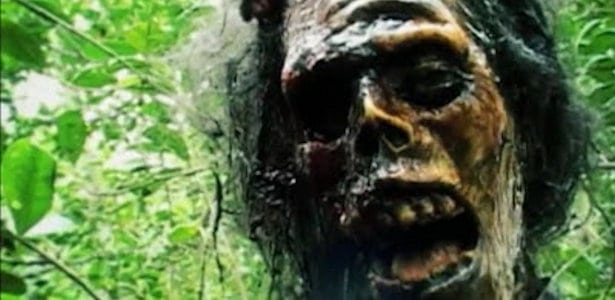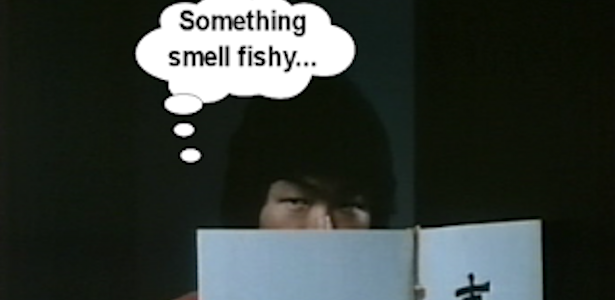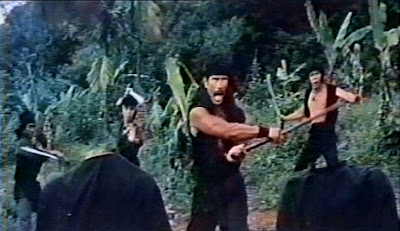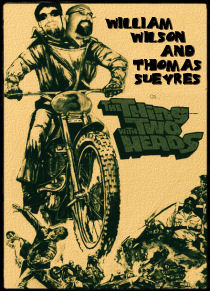To paraphrase Tony Anthony in BLINDMAN; being an H.P. Lovecraft fan ain’t easy. Being a Lovecraft fan and a movie fan? Well that’s a bitch!
Lovecraft adaptations have been around for a while, but tend to be pretty sparse. His work is essentially unfilmable, but if you are going to make the attempt the brevity of his stories are well suited to a short film medium. I think it’s safe to say that Hollywood doesn’t “get” Lovecraft. I bet the studio executives must have been driven as mad as Abdul Alhazred when he finished the last page of the Necronomicon, sitting in their meetings listening to someone pitch ideas that have vague words like “unseen” and “unknown” in it. Because of that it seems that Lovecraft has pretty much stayed in low-budget indy and student films. Not to sound cynical, but the thing of it is you don’t need much cash to have a movie about an unseen horror. The sticking point here is that you have to be able to tell a story and it has to wallow in atmosphere thicker than primordial ooze and it requires something in the way of decent acting. Aye there’s the rub.
Because of those limitations watching H.P. Lovecraft adaptations requires a different mindset. Like any book that is brought to screen, if you come into them expecting exact translations, you are just setting yourself up for disappointment. Even some of the most ballyhooed genre films, such as BLADE RUNNER (1982) and RE-ANIMATOR (1985), as much as I love them both, they really have very little to do with their source material. I’m not saying that running off into left field is always a good thing, so much as it isn’t always a bad thing and keeping an open mind is essential.
Everybody has their favorite Lovecraft stories and one of mine is “Cool Air”. I think it’s a story that, however brief, is not only creepy and atmospheric as it stands, but provides a great premise for a movie or short film. It’s a great idea, but it also doesn’t feature the “unfilmable” elements of many of his other stories. This one is about people, one of whom has a horrible secret. You can read the story in its entirety here.
ROD SERLING'S NIGHT GALLERY: COOL AIR (1971)
The earliest adaptation I can find of “Cool Air” is the 18th episode of NIGHT GALLERY which aired on December 8th 1971. In this version Serling decides he wants to put a romantic spin on the tale and changes the lead character (the narrator in the original story) to an attractive female (Barbara Rush) who tells the story in flashback from Dr. Munoz's grave. Here she is not a writer looking for a room, but merely trying to track down Munoz, to give him the news that her father, his friend of many years with whom he has been exchanging letters for some time, has died. Expecting an older man around her father’s age she is surprised to find Munoz (Henry Darrow) to be fit and swarthy, complete with whiskers and smoking jacket (ahhh the ‘70s!). This leads to many dinner conversations, candle-light conversations and moon-eyed flirty conversations in which you'd almost expect a tuxedo-clad violinist to pop into the scenes serenading our lovebirds. While watching this you’ll think “this must be going somewhere” and it is. After filling up it’s time with TV-style romance that would be considered timid in a G-rated movie, the last minutes feature the breakdown of the air-conditioning, the revelation of Dr. Munoz’s pruney corpse and the letter explaining it all.
Sometimes I wonder what the hell Rod was thinking when he wrote some of the stuff for NIGHT GALLERY. I had a discussion with my brother about this and I staunchly defended the integrity of the show based on 25 year old recollections. So I set out to sit down and start plowing through them and damned if he wasn’t right! While THE TWILIGHT ZONE still holds up as one of the best anthology television shows ever made, NIGHT GALLERY does not. It’s interesting to note that the NIGHT GALLERY adaptation of Pickman’s Model also is given new female lead and a strong romantic bent. I’m guessing Serling was using NIGHT GALLERY as some sort of televised catharsis, but either way, I ain’t havin' none of it.
THE HOUSE BY THE CEMETERY (1981)
“Steve?” “Steve?” “Steve!” “Steve?”
“Bob?” “Bob?” “Bob!” “Bob?”
In 1981 Lucio Fulci finished off his quadrilogy of E.A. Poe and H.P. Lovecraft inspired films with THE HOUSE BY THE CEMETERY. Out of the four films that included THE BEYOND (1981) and CITY OF THE LIVING DEAD (1980), Fulci wisely avoiding any direct adaptation of Poe or Lovecraft with the exception of THE BLACK CAT (1981) which is loosely based on the Poe story. If you do a direct adaptation, you open yourself up to a hail of negative criticism because it wasn’t done exactly the way each individual reader imagined it would when reading the story. Instead, if you do not point fingers at your literary sources, you gain praise for being influenced by great authors. Whether this was a conscious decision on Fulci’s part is debatable, but it made for some classic exploitation filmmaking. Seeming to start life as a modern reworking of Mary Shelly's “Frankenstein,” a plan perhaps scuttled by flaky backers, the finished film, THE HOUSE BY THE CEMETERY, is a gothic, very loose adaptation of “Cool Air”.
After a Boston scientist working on some secret project kills his family and commits suicide, another scientist, Dr. Boyle (Paolo Malco), is brought in to try to piece together the clues. For some reason Dr. Boyle and his family (Catriona MacColl and Giovanni Frezza as “Bob”) move into the house where the murder-suicide occurred. Known to the locals as The Freudstein house, the house is in a state of neglect to the point where some teen-ages are shown using it for a place to plow the beanfield before being slaughtered by an unseen assailant in the beginning of the film. Mrs. Boyle, who apparently has a mental condition, soon finds some weird shit going down; a sealed tomb in the middle of an entry hall, strange crying sounds, a cellar door that won’t open and her son Bob claiming to be getting warnings from a little girl that no one else can see. As it turns out the basement contains the subject of the previous doctor’s work, the long-dead corpse of Dr. Freudstein, a scientist who figured out how to keep himself alive in a state of undeath by killing everyone who sets foot in the house.
Obviously the screenwriters (including the genre icon Dardano Sacchetti) took the premise of “Cool Air” and ran with it. The film throws weirdness and unanswered questions at you from every conceivable angle (why is coffee more important than all that blood all over the kitchen floor?) and drenches you in gothic atmosphere. In fact the atmosphere is so thick and story so strange that it’s easy to be completely oblivious to the movie’s budgetary shortcomings. Almost the entire movie takes place in the house with occasional, and perfectly placed, cutaways to very small scenes in one or two locations. This adds to the claustrophobic atmosphere and at the same time broadens the scope of the film just enough to keep the viewer from getting bored seeing the same interiors over and over.
In addition to the camera prowling behind cobwebs thicker than Cousin It's hair, you have a great cast of regulars including the striking Ania Pieroni (TENEBRAE, 1982), the prolific Dagmar Lassander (A HATCHET FOR THE HONEYMOON, 1970), the frequently killed Daniela Doria (CITY OF THE LIVING DEAD), Gianpaolo Saccarola (THE BEYOND, 1981), and even Lucio Fulci himself, Dr. Boyle’s boss, who sets the plot in motion. For better or for worse, no discussion of a Fulci film is complete without mentioning the pretty extreme, even by modern standards, make-up effects. Here the brilliant Giannetto De Rossi provides the stunning carnage that turns disposing of a pesky bat into a grisly bloodbath of epic proportions. Surprisingly even the clarity of DVD doesn’t diminish the gory shocks as in many other films of the era, most notably THE BEYOND. It’s like listening to The Dead Boys or Black Flag on a digitally remastered CD instead of vinyl, somehow all that low fidelity noise made it so much more subversive. Of course I say that, but I don’t see myself going back to my old import VHS tapes any time soon!
NECRONOMICON: THE COLD (1993)
Bryan Yuzna made his name by producing Stuart Gordon’s seminal onslaught of black humor and bloody carnage RE-ANIMATOR (1985), something that both of them have been trying to cash-in on ever since (RE-ANIMATOR the musical? Ummmm… yeah).
In a weird twist, writers Kazunori Ito and Brent V. Friedman (who is also credited with writing Dan O’Bannon’s superlative 1992 Lovecraft film THE RESURRECTED) decide to remake Rod Serling’s take on the story with a female protagonist who is romantically involved with Dr. Munoz (David Warner). It’s basically a NIGHT GALLERY remake with RE-ANIMATOR sensibility. Again told in flashback by the female lead, the story tells of a teenage girl, Emily, who has run away from her drunken mother and sexually abusive step-father, answering the ad for a room to rent in an old Victorian. Once there the landlady (who turns out to be Munoz’s assistant) tells Emily of the elusive Munoz and his strange condition.
All of the elements of the story are included, such as the fluid dripping from the ceiling, but most have been slightly altered. Instead of a heart-attack, Emily finds herself unconscious in front of Munoz’s door when her step-father manages to track her down and puts out her lights. Unbeknownst to Emily, Munoz disposes of the bum with a scalpel and a staircase. The relationship develops from there and becomes “complicated” in the middle of the greenhouse where Munoz shows Emily his serum that when injected into the stem re-animates a dried rose. What he doesn’t tell her, at least right away, is that the serums efficacy is dependent on fresh spinal fluid. Of course all good things must come to an end with Munoz melting down in spectacularly gruesome fashion. The final twist regarding Emily’s pregnancy is a wonderfully nasty little bit of business that feels like it has its roots in EC Comics.
Shusuke Kaneko does a nice job of balancing the characters and chilling atmosphere with the over-the-top gore effects. Following this he went on to reinvent the GAMERA films with state of the art technology, but after trying to suffer through DEATH NOTE (2006), I feel like we lost another one to the Corporate Film-making Machine.
I guess it should be noted that the other two stories and the wrap-around segment are not actually based on any Lovecraft stories at all. The final one, WHISPERS, about two police officers following a serial killer and discovering subterranean aliens, is actually a reasonable facsimile of Clive Barker's short story “The Midnight Meat Train”.
A Contrast in Cool... Next!
Lovecraft adaptations have been around for a while, but tend to be pretty sparse. His work is essentially unfilmable, but if you are going to make the attempt the brevity of his stories are well suited to a short film medium. I think it’s safe to say that Hollywood doesn’t “get” Lovecraft. I bet the studio executives must have been driven as mad as Abdul Alhazred when he finished the last page of the Necronomicon, sitting in their meetings listening to someone pitch ideas that have vague words like “unseen” and “unknown” in it. Because of that it seems that Lovecraft has pretty much stayed in low-budget indy and student films. Not to sound cynical, but the thing of it is you don’t need much cash to have a movie about an unseen horror. The sticking point here is that you have to be able to tell a story and it has to wallow in atmosphere thicker than primordial ooze and it requires something in the way of decent acting. Aye there’s the rub.
Because of those limitations watching H.P. Lovecraft adaptations requires a different mindset. Like any book that is brought to screen, if you come into them expecting exact translations, you are just setting yourself up for disappointment. Even some of the most ballyhooed genre films, such as BLADE RUNNER (1982) and RE-ANIMATOR (1985), as much as I love them both, they really have very little to do with their source material. I’m not saying that running off into left field is always a good thing, so much as it isn’t always a bad thing and keeping an open mind is essential.
Everybody has their favorite Lovecraft stories and one of mine is “Cool Air”. I think it’s a story that, however brief, is not only creepy and atmospheric as it stands, but provides a great premise for a movie or short film. It’s a great idea, but it also doesn’t feature the “unfilmable” elements of many of his other stories. This one is about people, one of whom has a horrible secret. You can read the story in its entirety here.
ROD SERLING'S NIGHT GALLERY: COOL AIR (1971)
The earliest adaptation I can find of “Cool Air” is the 18th episode of NIGHT GALLERY which aired on December 8th 1971. In this version Serling decides he wants to put a romantic spin on the tale and changes the lead character (the narrator in the original story) to an attractive female (Barbara Rush) who tells the story in flashback from Dr. Munoz's grave. Here she is not a writer looking for a room, but merely trying to track down Munoz, to give him the news that her father, his friend of many years with whom he has been exchanging letters for some time, has died. Expecting an older man around her father’s age she is surprised to find Munoz (Henry Darrow) to be fit and swarthy, complete with whiskers and smoking jacket (ahhh the ‘70s!). This leads to many dinner conversations, candle-light conversations and moon-eyed flirty conversations in which you'd almost expect a tuxedo-clad violinist to pop into the scenes serenading our lovebirds. While watching this you’ll think “this must be going somewhere” and it is. After filling up it’s time with TV-style romance that would be considered timid in a G-rated movie, the last minutes feature the breakdown of the air-conditioning, the revelation of Dr. Munoz’s pruney corpse and the letter explaining it all.
Sometimes I wonder what the hell Rod was thinking when he wrote some of the stuff for NIGHT GALLERY. I had a discussion with my brother about this and I staunchly defended the integrity of the show based on 25 year old recollections. So I set out to sit down and start plowing through them and damned if he wasn’t right! While THE TWILIGHT ZONE still holds up as one of the best anthology television shows ever made, NIGHT GALLERY does not. It’s interesting to note that the NIGHT GALLERY adaptation of Pickman’s Model also is given new female lead and a strong romantic bent. I’m guessing Serling was using NIGHT GALLERY as some sort of televised catharsis, but either way, I ain’t havin' none of it.
THE HOUSE BY THE CEMETERY (1981)
“Steve?” “Steve?” “Steve!” “Steve?”
“Bob?” “Bob?” “Bob!” “Bob?”
In 1981 Lucio Fulci finished off his quadrilogy of E.A. Poe and H.P. Lovecraft inspired films with THE HOUSE BY THE CEMETERY. Out of the four films that included THE BEYOND (1981) and CITY OF THE LIVING DEAD (1980), Fulci wisely avoiding any direct adaptation of Poe or Lovecraft with the exception of THE BLACK CAT (1981) which is loosely based on the Poe story. If you do a direct adaptation, you open yourself up to a hail of negative criticism because it wasn’t done exactly the way each individual reader imagined it would when reading the story. Instead, if you do not point fingers at your literary sources, you gain praise for being influenced by great authors. Whether this was a conscious decision on Fulci’s part is debatable, but it made for some classic exploitation filmmaking. Seeming to start life as a modern reworking of Mary Shelly's “Frankenstein,” a plan perhaps scuttled by flaky backers, the finished film, THE HOUSE BY THE CEMETERY, is a gothic, very loose adaptation of “Cool Air”.
After a Boston scientist working on some secret project kills his family and commits suicide, another scientist, Dr. Boyle (Paolo Malco), is brought in to try to piece together the clues. For some reason Dr. Boyle and his family (Catriona MacColl and Giovanni Frezza as “Bob”) move into the house where the murder-suicide occurred. Known to the locals as The Freudstein house, the house is in a state of neglect to the point where some teen-ages are shown using it for a place to plow the beanfield before being slaughtered by an unseen assailant in the beginning of the film. Mrs. Boyle, who apparently has a mental condition, soon finds some weird shit going down; a sealed tomb in the middle of an entry hall, strange crying sounds, a cellar door that won’t open and her son Bob claiming to be getting warnings from a little girl that no one else can see. As it turns out the basement contains the subject of the previous doctor’s work, the long-dead corpse of Dr. Freudstein, a scientist who figured out how to keep himself alive in a state of undeath by killing everyone who sets foot in the house.
Obviously the screenwriters (including the genre icon Dardano Sacchetti) took the premise of “Cool Air” and ran with it. The film throws weirdness and unanswered questions at you from every conceivable angle (why is coffee more important than all that blood all over the kitchen floor?) and drenches you in gothic atmosphere. In fact the atmosphere is so thick and story so strange that it’s easy to be completely oblivious to the movie’s budgetary shortcomings. Almost the entire movie takes place in the house with occasional, and perfectly placed, cutaways to very small scenes in one or two locations. This adds to the claustrophobic atmosphere and at the same time broadens the scope of the film just enough to keep the viewer from getting bored seeing the same interiors over and over.
In addition to the camera prowling behind cobwebs thicker than Cousin It's hair, you have a great cast of regulars including the striking Ania Pieroni (TENEBRAE, 1982), the prolific Dagmar Lassander (A HATCHET FOR THE HONEYMOON, 1970), the frequently killed Daniela Doria (CITY OF THE LIVING DEAD), Gianpaolo Saccarola (THE BEYOND, 1981), and even Lucio Fulci himself, Dr. Boyle’s boss, who sets the plot in motion. For better or for worse, no discussion of a Fulci film is complete without mentioning the pretty extreme, even by modern standards, make-up effects. Here the brilliant Giannetto De Rossi provides the stunning carnage that turns disposing of a pesky bat into a grisly bloodbath of epic proportions. Surprisingly even the clarity of DVD doesn’t diminish the gory shocks as in many other films of the era, most notably THE BEYOND. It’s like listening to The Dead Boys or Black Flag on a digitally remastered CD instead of vinyl, somehow all that low fidelity noise made it so much more subversive. Of course I say that, but I don’t see myself going back to my old import VHS tapes any time soon!
NECRONOMICON: THE COLD (1993)
Bryan Yuzna made his name by producing Stuart Gordon’s seminal onslaught of black humor and bloody carnage RE-ANIMATOR (1985), something that both of them have been trying to cash-in on ever since (RE-ANIMATOR the musical? Ummmm… yeah).
In a weird twist, writers Kazunori Ito and Brent V. Friedman (who is also credited with writing Dan O’Bannon’s superlative 1992 Lovecraft film THE RESURRECTED) decide to remake Rod Serling’s take on the story with a female protagonist who is romantically involved with Dr. Munoz (David Warner). It’s basically a NIGHT GALLERY remake with RE-ANIMATOR sensibility. Again told in flashback by the female lead, the story tells of a teenage girl, Emily, who has run away from her drunken mother and sexually abusive step-father, answering the ad for a room to rent in an old Victorian. Once there the landlady (who turns out to be Munoz’s assistant) tells Emily of the elusive Munoz and his strange condition.
All of the elements of the story are included, such as the fluid dripping from the ceiling, but most have been slightly altered. Instead of a heart-attack, Emily finds herself unconscious in front of Munoz’s door when her step-father manages to track her down and puts out her lights. Unbeknownst to Emily, Munoz disposes of the bum with a scalpel and a staircase. The relationship develops from there and becomes “complicated” in the middle of the greenhouse where Munoz shows Emily his serum that when injected into the stem re-animates a dried rose. What he doesn’t tell her, at least right away, is that the serums efficacy is dependent on fresh spinal fluid. Of course all good things must come to an end with Munoz melting down in spectacularly gruesome fashion. The final twist regarding Emily’s pregnancy is a wonderfully nasty little bit of business that feels like it has its roots in EC Comics.
Shusuke Kaneko does a nice job of balancing the characters and chilling atmosphere with the over-the-top gore effects. Following this he went on to reinvent the GAMERA films with state of the art technology, but after trying to suffer through DEATH NOTE (2006), I feel like we lost another one to the Corporate Film-making Machine.
I guess it should be noted that the other two stories and the wrap-around segment are not actually based on any Lovecraft stories at all. The final one, WHISPERS, about two police officers following a serial killer and discovering subterranean aliens, is actually a reasonable facsimile of Clive Barker's short story “The Midnight Meat Train”.
A Contrast in Cool... Next!




